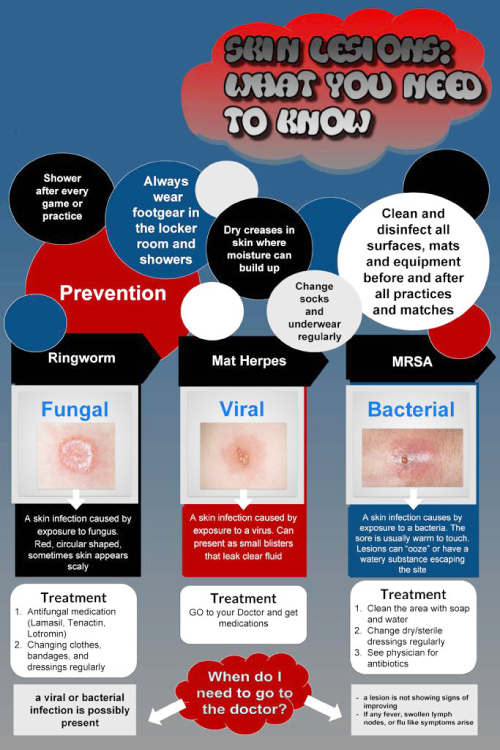Academy Menu

Supplemental Lessons
Infectious Skin Diseases
Combat Sport Athletes Are At Risk For

Combat sport athletes are susceptible to various infectious skin diseases due to the close physical contact and potential for skin-to-skin transmission during training and competition. These athletes often face a higher risk of skin infections, ranging from common conditions to more severe and contagious diseases. In this exploration, we will delve into several infectious skin diseases that combat sport athletes may encounter, highlighting their causes, symptoms, and preventive measures.

One prevalent skin infection is Ringworm, caused by various fungi known as dermatophytes. Combat athletes, engaging in activities that promote skin-to-skin contact, are at increased risk. Ringworm manifests as circular, red, and itchy patches on the skin, often with a more defined border. Maintaining good personal hygiene, regular skin checks, and avoiding sharing personal items can help prevent its spread.
Impetigo is another common bacterial skin infection that combat sport athletes may face. Caused by Staphylococcus aureus or Streptococcus pyogenes, it presents as red sores that rupture and develop a characteristic honey-colored crust. Good hygiene practices, such as regular handwashing and proper wound care, are crucial in preventing impetigo transmission.
Herpes gladiatorum, caused by the herpes simplex virus (HSV), is a highly contagious skin infection prevalent in combat sports. Athletes may develop painful, fluid-filled blisters, often on the face, neck, or shoulders. Using appropriate protective gear, such as face shields, and avoiding contact during active outbreaks can help reduce the risk of transmission.
Folliculitis, an infection of the hair follicles, is another concern for combat sport athletes. Staphylococcus aureus is a common causative agent. It presents as red, swollen, and pus-filled bumps around hair follicles. Maintaining clean training environments, showering promptly after practice, and avoiding shared towels can aid in preventing folliculitis.
Tinea corporis, also known as body ringworm, is a fungal infection affecting the body’s glabrous (non-hairy) skin. Combat athletes may contract it through skin-to-skin contact or contaminated surfaces. Red, scaly, and circular lesions characterize the infection. Athletes should practice good hygiene, regularly clean training equipment, and avoid sharing personal items to minimize the risk.
Cellulitis, a bacterial skin infection, can also affect combat sport athletes. It typically occurs when bacteria enter through a break in the skin, leading to redness, swelling, and warmth. Prompt wound care, including cleaning and covering cuts and abrasions, is essential in preventing cellulitis.
Molluscum contagiosum, caused by a poxvirus, is a viral skin infection that combat athletes might encounter. It presents as small, dome-shaped, pearly lesions with a central dimple. Athletes should avoid skin-to-skin contact with affected areas and refrain from sharing personal items to prevent the spread of molluscum contagiosum.
To tackle these infectious skin diseases, preventive measures are paramount. Combat sport athletes should prioritize personal hygiene, including regular showering, keeping training environments clean, and using clean towels. Wearing appropriate protective gear, such as rash guards and headgear, can act as a barrier against skin-to-skin contact. Athletes should also be educated on the importance of prompt wound care to prevent bacterial infections.
Regular skin checks and immediate medical attention for any suspicious lesions or rashes are crucial in early detection and containment of infectious skin diseases. In addition, promoting awareness and providing education about these infections within the combat sports community can contribute to a safer training and competitive environment.
Combat sport athletes face a heightened risk of infectious skin diseases due to the nature of their sport. Recognizing the symptoms, understanding the causes, and implementing preventive measures are essential in safeguarding the well-being of these athletes. By prioritizing hygiene, using protective gear, and fostering awareness, the combat sports community can collectively work towards minimizing the prevalence and impact of infectious skin diseases.

Thut Ti Lethwei Global Academy Disclaimer
The information provided on Thut Ti Lethwei Global Academy (lethwei.net) is intended for general informational and educational purposes only. The content on this Website is not intended as a substitute for instruction or direction from a professional combat sports coach or martial arts instructor. The content is also not intended as a substitute for medical direction, advice, diagnosis, or treatment from a health care professional. Always seek the advice of your physician or other qualified health provider with any questions you may have regarding a medical condition or th e safety of participating in any physical activity.
Not Medical Advice: The content on this Website is not intended to be a substitute for professional medical advice, diagnosis, or treatment. Always seek the advice of your physician or other qualified health provider with any questions you may have regarding a medical condition.
Consult a Professional: It is essential to consult with a healthcare professional before starting any new activity program, diet, or exercise routine. Your individual training goals should be discussed with a qualified healthcare provider who can provide personalized recommendations.
Assumption of Risk: Participation in physical activity and exercise carries inherent risks, and by using the information provided on this Website, you acknowledge and voluntarily assume these risks. Always exercise caution and common sense when engaging in physical activities.
Accuracy of Information: While we strive to provide accurate and up-to-date information, the content on this Website may not always reflect the most current research or medical guidelines. We do not guarantee the accuracy, completeness, or timeliness of the information presented.
Responsibility: You are responsible for your health and safety when engaging in any combat sport, martial art, or fitness program, individual exercise, or dietary practice discussed on this Website. Thut Ti Lethwei Global Academy, its authors, contributors, and affiliates disclaim any liability for any injury, loss, or damage incurred as a result of the use or reliance on the information provided on this Website.
Changes to Disclaimer: Thut Ti Lethwei Global Academy reserves the right to modify or update this disclaimer at any time without prior notice. It is your responsibility to review this disclaimer periodically for any changes.
By using Thut Ti Lethwei Global Academy website, you agree to the terms of this disclaimer. If you do not agree with these terms, please refrain from using this website.
